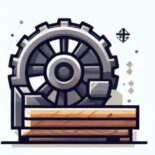Maximizing Efficiency: Cost-Effective Strategies for Industrial Machinery Maintenance
When it comes to industrial machinery maintenance, maximizing efficiency while minimizing costs is crucial for businesses. One cost-effective strategy that companies can employ is the replacement of components in their machinery. By regularly assessing the condition of key components such as bearings, belts, and motors, businesses can identify potential issues early on and prevent costly breakdowns.
Replacing worn or damaged components proactively can help avoid unexpected downtime and production losses. Additionally, opting for high-quality, durable components may initially entail a higher investment but can result in long-term cost savings by reducing the frequency of replacements and maintenance.
Furthermore, partnering with reliable suppliers and manufacturers for industrial machinery components is essential. Building strong relationships with suppliers can lead to cost savings through bulk purchasing, favorable pricing agreements, and access to expert guidance on maintenance best practices.
In summary, by prioritizing proactive component replacement, investing in high-quality parts, and fostering strong supplier relationships, businesses can efficiently maintain their industrial machinery while keeping costs in check.
Upgrading for Savings: Replacing Components in Industrial Machinery for Improved Cost Efficiency
When it comes to industrial machinery, replacing components can be a costly but necessary expense. However, by carefully considering cost-effective solutions and focusing on upgrading components for improved efficiency, companies can actually save money in the long run. Upgrading components in industrial machinery is a strategic approach to improving cost efficiency and extending the lifespan of equipment.
One cost-effective solution is to replace outdated or inefficient components with modern, high-performance alternatives. While the initial investment may seem significant, the long-term savings in terms of energy efficiency, reduced maintenance, and increased productivity can far outweigh the upfront costs. Upgrading components such as motors, drives, and control systems can result in substantial energy savings, making the machinery more cost-effective to operate over time.
Another aspect to consider is the potential for reducing downtime and maintenance costs. Aging components are more prone to failure, leading to unexpected downtime and costly repairs. By proactively replacing components before they fail, companies can avoid these unplanned expenses and keep their machinery running smoothly. This approach not only saves money but also contributes to a more efficient and reliable production process.
Furthermore, upgrading components can also lead to improved product quality and overall operational efficiency. For example, replacing old sensors with advanced, more accurate ones can result in better control of the manufacturing process and higher-quality products. This can lead to fewer defects, less waste, and ultimately, cost savings for the company.
In conclusion, while the upfront cost of replacing components in industrial machinery may seem daunting, the long-term benefits far outweigh the initial investment. By focusing on upgrading for savings, companies can achieve improved cost efficiency, reduced downtime, and enhanced operational performance, ultimately contributing to a more competitive and sustainable business.
